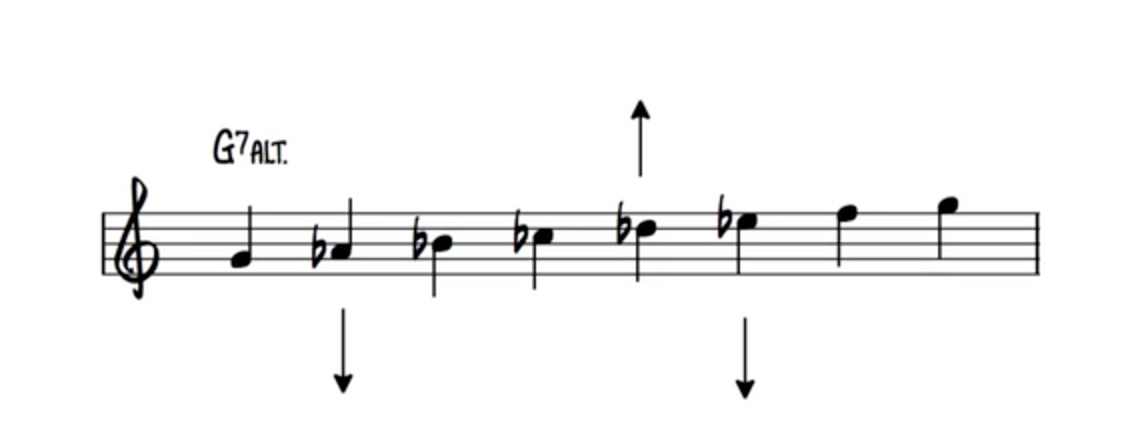Any suggestion for target notes to end / resolve - aim at in constructing an end of an improvised line. Ways to think about this. Resolution or delayed resolution. This concept in the lessons has been very helpful in increasing my ability to create better sounding lines.
Hey Keith… good question!
We have an intermediate/advanced lesson on the topic of “Target Tones & Approach Patterns” : https://www.pianogroove.com/jazz-piano-lessons/approach-patterns-target-notes/
We use the tune “Alone Together” to demonstrate a number of important improvisation principles:
-
Always have a point in mind where you will resolve you line. This will stop you wandering up and down scales with little direction.
-
Chromaticism is you best friend when improvising. It can get you out tight spaces and make your lines sound more professional.
-
Use chromaticism to target primary chord tones or extensions. The primary chord tones are a ‘safe place’ and they bring stability to your improvised lines and ideas. Targeting the 3rd is particularly effective. Also remember that you can outline the voice leading in you lines (7ths falling to 3rds in a 251 for example).
-
Try adding enclosures to your lines. An enclosure is where you play the tones on either side of the target tone. You can take this a step further with double enclosures, where you play 2 notes
The lesson highlighted above is from the course on “Improvisation & Soloing”. In that course you can find three lessons on “Alone Together” which is a really nice tune for exploring minor 251 and altered scale improvisation.
Hayden, I went through the course and that’s where I came up with the question
You state,”Always have a point in mind where you will resolve you line. This will stop you wandering up and down scales with little direction.”
Can you suggest some ideas for choosing this “point in mind where you will resolve your line?”
This improvising lesson is great.
Okay great here’s some extra information:
-
Aim for primary chord tones and sometimes extensions when resolving you lines. The primary chord tones are stable, consonant sounding tones. The extensions have a prettier sound but are not as stable sounding as the primary chord tones.
-
If it is a 251 progression, then you always have the guide tones (7ths falling to 3rds) - this will always sound great as your are improvising directly within the harmony by outlining the voice leading in your lines.
-
If you have been playing alterations, perhaps using the altered scale or HW Dim scale over a V chord, then you can also look for other points of resolution…
-
I demonstrated 2 resolution points using the below diagram in the lesson on the Altered Mode Improv (See the third chapter “Resolve Tension”)
-
You can see that we have a G7alt chord which would be the V in a 251 in C Major. Over the G7alt, we have the altered mode which contains all alterations.
-
I have highlighted two common points of resolution, the first is the b9 of G7 which resolves down a half step into the 5th of C Major.
-
Another nice point of resolution is into the 9th of the I chord which can be approached from either direction. For G7alt, this would be the #11 or the #5 resolving into the 9th of the I chord. You could also create an enclosure with these 2 tones as they are either side of the target tone.
-
The important thing to understand here is that we are moving from very tense, dissonant tones over the G7 into more consonant sounding tones over the Cmaj7. Tension and Release.
What I would recommend for you:
1. Play around with a 251 in C Major just like in the lesson highlighted above. Systematically work through each point of resolution from V to I. Start with the primary chord tones (root, 3, 5, 7) and then try the extensions (9, 11, 13) and you will gain a sense of aural appreciation for what it sound like to land on the 3rd for example, or the 9th, or the 5th. Each has a very different sound which you should be aware of. Remember that this information can then be applied to any key to achieve the same effect.-
It’s then very important that you are listening and transcribing your own lines and solos. In my opinion, transcription is hands down the most effective way to develop your improvisation abilities. Check out the thread on Transcription and the course on transcription for more information. I will be adding more to this thread in early Jan to encourage students to really get stuck into transcribing lines and solos in 2018.
-
From watching the altered mode lesson (and other improv tutorials), it will give you the theoretical understanding to analyse what you are hearing on records. This is where the real learning starts. Learning to transcribe is a difficult and slow process to begin with, but it will have huge benefits for you playing and you will soon get to the point where you can pick things out quickly.
For example, one of the lines demonstrated in the altered mode lesson has a very distinctive sound and you hear it all the time in improvised solos. Over the V chord: #9-b9-#5-3-#9-b9 → resolving down a half step into the 5th of I chord - also known as the “cry me a river lick”. When i hear those tones being played in a solo, it jumps out at me immediately, no matter what key, because I am familiar with the sound of that altered scale pattern.
The point is… the more you listen and transcribe, the more ideas you will have when you come to improvise.
I hope this helps give you some direction Keith… let me know if you’d like me to elaborate on anything here 
Hayden. Thanks for the great answer
